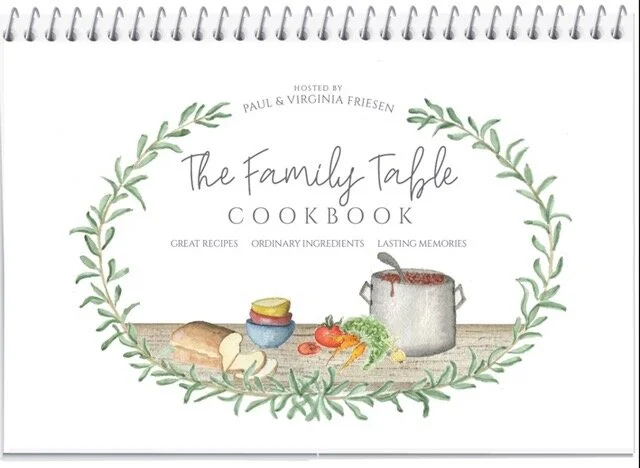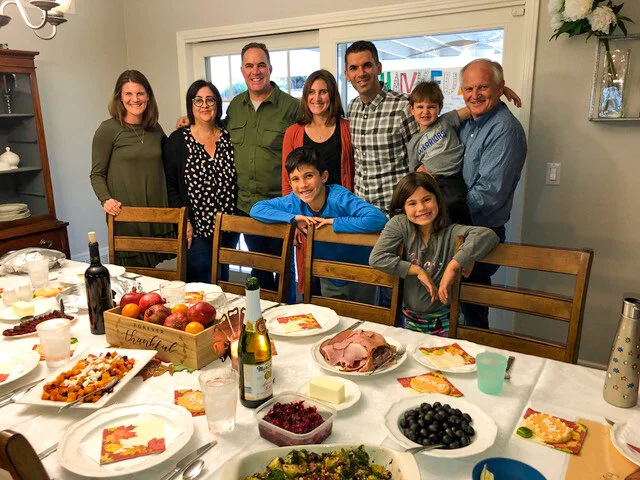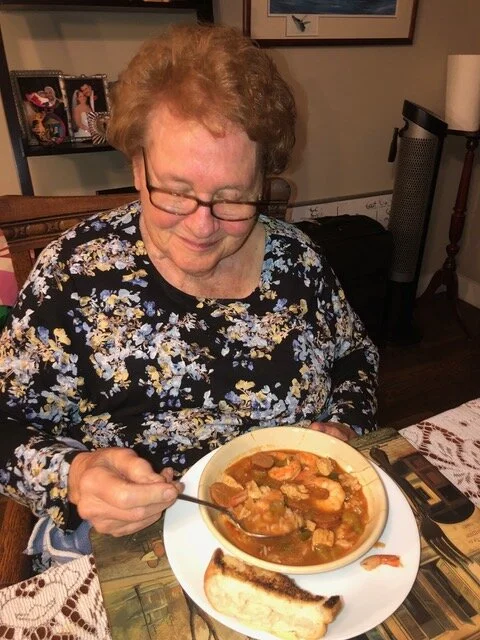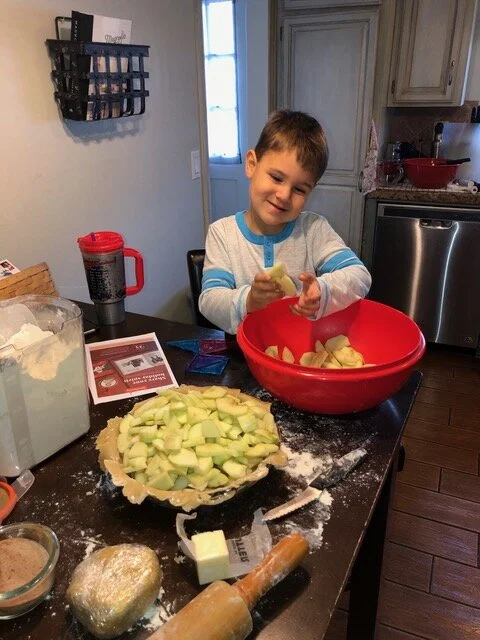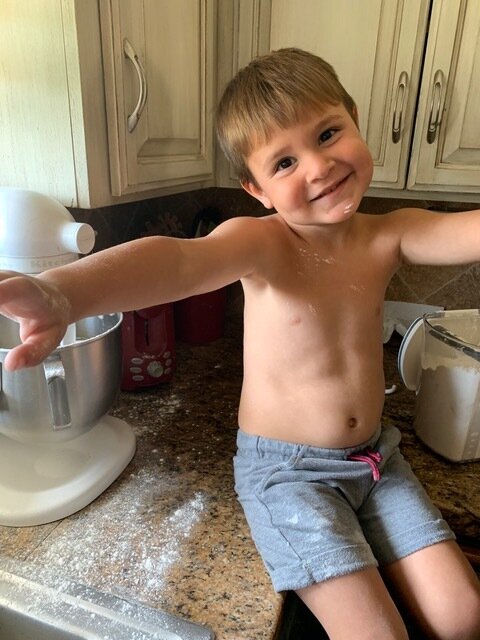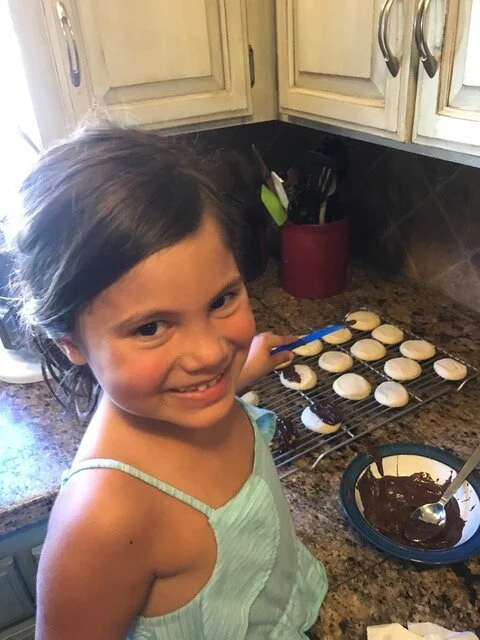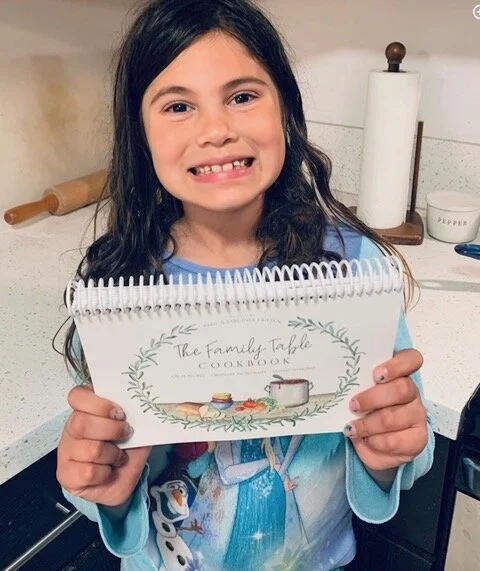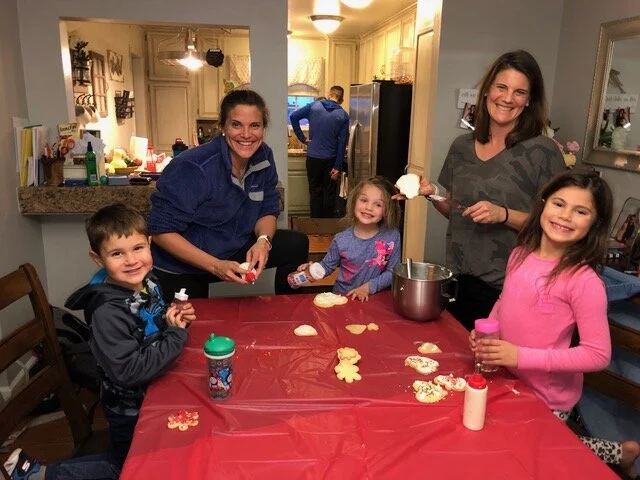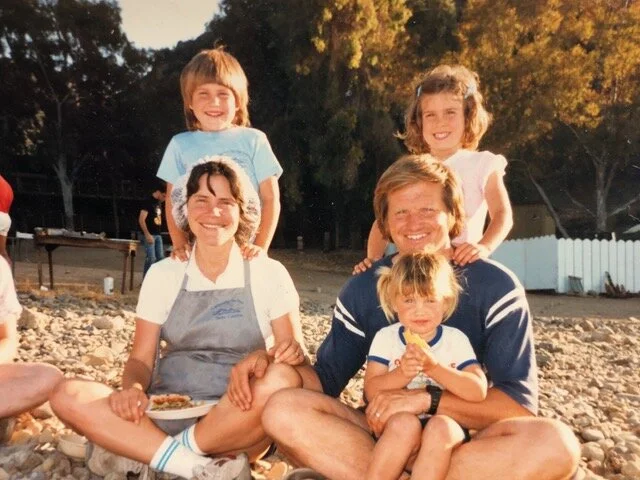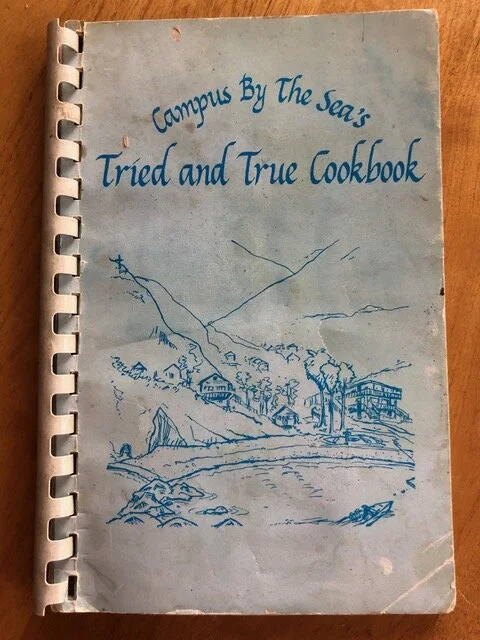It was a sweltering summer day in Louisiana. My 8-year-old self stood in the kitchen of my paternal grandparents’ home in Shreveport, watching with fascination as Grandma Collins stirred the hot pot of boiling figs, on their way to becoming preserves. With sweat running down her brow, just beneath the thin brown elastic that kept her hair net in place over her thinning curly hair, she turned to me and said, “You know, Virginia, the way to a man’s heart is through his stomach.” With that piece of wisdom pronounced, she simultaneously clicked her cheek and winked her eye at her wide-eyed granddaughter, leaving an unforgettable impression.
The fam standing on the front porch of Grandpa and Grandma Collins’ home in Shreveport, LA. My grandma is in the upper right corner, and my Great Aunt Kay is standing in front of her. Yours truly is standing in the middle front. Clearly we were dressed and ready for church.
Whether or not that bit of conventional wisdom still holds true in our day of fast food, prepared meals, and a plethora of restaurants replacing good ole home cooking, that spontaneous declaration from my grandmother was one of the sparks that ignited in me a lifelong love for home-cooked meals and their power to not just nourish, but to convey blessing and love.
Raised in a family of seven children (six girls and the seventh a boy, the oldest turning twelve four days before the youngest was born), food was kind of a “big” deal—nourishing, but simple, rationed, and homemade. It was in the sixties that I became aware of conveniences such as “slice and bake” cookies, brownie mixes, etc., though none of those modern day culinary advances came in to our home because “we couldn’t afford them.” I decided then that when I was an adult, I would surely indulge in such amazing, easy confections. Once I was grown-up, I mused, I wouldn’t have to settle for envying my neighborhood friends, whose mothers could afford such luxuries. I’d buy my own.
I’m not sure how many years passed before I realized the folly of my thinking, but I do know that even before I was all grown up, I fell in love with all things homemade from “scratch.” This growing passion was met with delight by my dear Mama, who fulfilled her duty in the kitchen to keep her very large, hungry crew fed, but she never really loved it. She was more than happy to step aside as her daughters, one by one, discovered the “joy of cooking”—most likely motivated initially by a love for eating, but later fueled by the joy of giving to others from the heart of the kitchen.
And so began my journey into developing culinary skills and collecting recipes, of which I never seemed to tire. Though partial to baking breads and desserts, I was always on the look-out for perfectly irresistible main dish, salad, and veggie recipes as well. As the years passed, my perfectionistic tendencies tempered by my creative genes have freed me to adjust recipes to my liking, but in those early years, I stuck fastidiously to the directives of the written recipes.
We had only been married for four months when I had my first disastrous company meal. “Swiss Steak” had been served at our wedding rehearsal dinner in April of 1976, prepared in the kitchen of our church’s fellowship hall by a crew of servant-hearted people who loved us. It was truly a hit and “simple to prepare” announced the cooks as the compliments poured in. That culinary experience was tucked away in my mind and surfaced as I considered what to prepare for our very special first dinner guests and prompted a call to the cook who had prepared it for our wedding party only months earlier.
I took copious notes as she walked me through the recipe, reciting it from her memory, having made it so many times before. And four hours before dinner would be served (Swiss steak bakes foil covered in a slow oven for 4 hours in order to tenderize a cheap cut of beef), I followed her instructions to a “T” before putting it in the oven for its long afternoon nap.
The doorbell rang announcing the arrival of our guests (a “chosen family” couple our parents' age) and as Paul greeted them, I stayed in the kitchen to remove what I expected would be the perfectly done Swiss Steak. As I took off the foil, I was beyond shocked (horrified?) to see four shriveled up, hockey-puck-like, inedible beef-beyond-jerky sitting in a dried up pan.
Panic. Horror. Embarrassment. Paralysis.
I could hear Paul making small talk with our guests and I knew he was wondering why I hadn’t come out of the kitchen to greet them yet. I finally was able to voice, “Paul. I need you in here.”
To this day, I’ll never forget his reaction to his young, new bride who was about to burst into tears. As he looked at the lumps in the pan that were clearly neither identifiable nor edible, he said, “Good thing we have some steaks in the freezer from our butcher friend! Dinner will only be slightly delayed!” And our dinner guests were duly impressed that we served them a very yummy, high-end steak dinner.
I made a call the next day to the person who had conveyed the Swiss Steak instructions to me and “where I went wrong” was illuminated as I read back her directions from the day before. “And then you said to put 1/2 cup of water in the pan…” at which point she gasped and said, “Oh no! I meant to say pour in enough water ’til you have 1/2” covering the bottom of the pan.” I never had trouble making Swiss Steak after that.
There have certainly been other culinary disasters along the four plus decades of our married life, but reflecting on that pivotal evening, I’m so grateful for the reaction of my non-catastrophizing husband, who to this day, problem solves with grace and calm.
Paul and I both came from large families who never wondered “what should we do with all the money we make,” and that largely shaped our journey with food. Eating out was not even a thought, except on a rare occasion, so we grew up with home cooking as the norm and the “family table” as the center of family life. I realize this sounds very ancient, but both of our families predictably ate the dinner meal together, most every night. Youth sports, microwaves, take-out food, prepared foods, cell phones, the internet, specialized diets, etc., were all yet to shift the paradigm of cultural norms around eating.
The “family table” was where family culture was developed. Far greater than just the physical act of feeding people, multiple values were conveyed around the family table. The importance of our faith was affirmed as we started each meal with prayer. The value of sharing and considering others was expected as we passed around the family-style serving bowls, aware that they needed to make it around to every mouth at the table. Manners were taught and enforced, from the unacceptability of burping to the “no reading your book” during the meal. (I was known to sneak whatever book I was reading on to my lap, just under the table edge, when I was very engrossed in a chapter as the dinner bell rang.). Communication skills were developed as we learned to listen to one another, to not interrupt, and to contribute to the conversation. And family history was shared, often triggered by something being served at the meal. Family folklore following “remember when…” usually evoked laughter and delight, making lasting deposits into the security found in our shared heritage. Awareness that I was not the center of the universe was reinforced as everyone patiently waited for everyone to be finished eating before asking, “May I please be excused?” Learning the importance of serving was both modeled and applied as we pitched in to set and clear the table, followed by washing the dishes, wiping the counters, and sweeping the floor.
Speaking of setting the table, we learned how to make a "proper fuss” when the meal was a celebration of a special occasion. Like every Sunday—after church, we used the china dishes for Sunday dinner, conveying the “set apartness” of the Lord’s Day. Dinner would be different than the other six days of the week as Mama would either fry chicken (affirming her Southern roots) or slow cook a roast. Both meals which would be accompanied by homemade gravy, rice or mashed potatoes, a salad, and Mama’s famous baking powder biscuits. That same serving china would come out on birthdays or holidays, reinforcing that celebrations link together traditions and values, which help to establish cherished legacy.
Making a proper fuss for Thanksgiving dinner with Lisa (far left) and daughter Kari’s family, in their home, and including “chosen family” members, Jay and Yukiko Dreves.
In Pixley, CA, at the “Friesen family farm” where the generations gather for Thanksgiving annually...
Maybe the most important value emphasized was gratitude. As we began each meal with a prayer, thanking the Lord for His constant provision and faithfulness, we ended the meal by expressing thanks to the cook. Before we left the table, this sentiment was expressed by each one: “Thank you so much for the _____ meal, Mama. May I please be excused?” The “_____” was an ever-changing adjective, from “nothing,” to “delicious,” to “my favorite,” to “nourishing” (used when it really wasn’t a favorite.) This posture of thanks shaped our view that we were indeed blessed to even have food on our table, and additionally affirmed the Lord’s provision, our father’s labor which “brought home the bacon”, and our mother’s hard work to serve us. We learned to eat what was served and to be thankful for it. The idea of the “in home short order cook” who caters to each person’s personal preference and pickiness was an idea foreign to The Family Table up until the late eighties. A request to eat something other than what was served would’ve been met with “What do you think this is? A diner??” The answer would have been a stunned emphatic “No.”
The “family table” was piled with food prepared in our kitchen, which became the laboratory for passing on culinary secrets from generation to generation. A very poignant memory is when daughters Kari and Lisa asked their aging Grammie Essie to teach them how to make “Gumbo.” This very special/time consuming dish was mastered by my New Orleans born and bred Mama. The girls recognized that the intangibles of the recipe would die with her at some point were it not passed on intentionally. “Grammie” agreed to the tutorial and sat perched on a bar stool, verbally instructing them how to make a good “roux” (“The secret of a good pot of gumbo,” she relayed), and watched and talked them through each step of the process. “Gumbo” is the traditional New Year’s Eve meal for Kari’s family now, carrying on a generational favorite.
Grammie Essie eating a bowl of gumbo.
Passing recipes and traditions through the generations is often inconvenient, messy, and/or time-consuming (and often all three!), but the values transmitted far outweigh the time “lost” in clean up or inefficiency.
Micah doesn’t miss a chance to be in the kitchen “helping.”
Whoops!! Turned the mixer on at high speed!
Ana used to be as “messy and inefficient” as little brother, but is truly a valuable helper by age 7.
She loves to be in the kitchen with her mom and was thrilled to receive the cookbook.
Another value . . . time together, doing something fun that tastes good, too.
The role of food in our lives expanded as Paul became the director of a Christian camp in 1975. Back in the day, “camp food” was notoriously cheap, simple, and starchy. Bisquick, canned vegetables, canned fruit, and store-bought bread and cereals were the norm. Not many people “raved” about camp food back then.
Except at this camp. The food service director in the 1960’s was Sue Gregg, who put together menus and recipes that were affordable AND pleasing to the campers. Meatloaf, beef ole, shepherd’s pie, cinnamon rolls, and homemade bread were staples at camp during Sue’s years and the word on the street was that “THIS camp food was different in the best possible way.” Two of Paul’s sisters (Joyce and Beth) followed Sue Gregg as food service directors in the 70’s and early 80’s, reinforcing the belief that camp food could be good! Using their creativity and innovative ideas, homemade hamburger and hot dog buns and homemade granola were added to the fare. All of the bread was homemade, BY HAND, for up to 200 campers, until camp was able to purchase and run (after electricity was brought in to camp in 1981) a Hobart stand mixer. To further complete the sibling-run camp kitchen, my youngest sister Laura followed Beth as head cook for a couple of years. She, too, was committed to serving up great food at camp. Following Laura, for the next ten years I served as food service director.
Our reigning philosophy regarding the dining hall was that it was an integral part of loving people into the Kingdom. We believed that if campers were unhappy in the dining hall, they’d be less inclined to have open hearts in the meeting halls where the gospel would be proclaimed. Conversely, if they were loved well in the dining hall with great food and service, their hearts would be more open to the work of the Holy Spirit during meetings. Dining had the potential to be so much more than just calming growling stomachs.
Once a week, the “hamburgers on the beach” meal was served, creating a summer picnic at the beach event which everyone loved. This photo, circa 1984, features our two oldest daughters and our niece, enjoying this relaxing, outdoors meal. I’m still donning my hair net and apron, suggesting I was taking a short dinner break with the family prior to returning to the kitchen.
Driven by the philosophy behind the scenes, combined with great cooking and baking, the value of the “family table” was affirmed three times a day, seven days a week at camp. Under Paul’s leadership from 1975 through 1991 (full time) and up through 2015 (part time), all meals at camp were served family style, for the same reasons we served family style on a micro-level in our home.
We shared the same passion for meal times at camp being so much more than a “food dump,” and thus established sacred rhythms which conveyed life-shaping, community values as the heart and soul of our family camps. After the 250 campers and staff assembled in the dining hall, standing behind their chairs around the tables of 8-10, each meal was started by the whole community reciting the weekly memory verse, followed by a prayer of gratitude. Serving was modeled by our staff as they tended the tables, allowing all of our guests to peacefully enjoy the meal seated instead of running about a busy dining hall, and the staff servers impressed on all the joy of serving. No one left the dining hall until announcements were made, affirming the value of community, and during that announcement time, birthdays and anniversaries were also celebrated. The camp tradition of clean-up carrying the “KP” moniker was replaced early in our tenure with “Opportunity to Serve” (OTS), and families were assigned OTS twice during their week at camp. The OTS team of 20 would be a mix of several families who would work together to get the dining room cleaned up. Community life at its best.
In February 1980, a flood destroyed many of the buildings at camp. Eighteen months later, our very first cookbook was born and published. We produced the cookbook as a thank you gift for the many donors who had sacrificially given to rebuild camp. The many requests we fielded each summer for camp recipes inspired the vision that this would be a welcomed thank you, and indeed it was.
This well worn copy of the “Tried and True Cookbook,” featuring artwork by Bob Bartel who captured the first rendering of the completed “Lighthouse” dining hall post-flood, was produced and given as a thank you gift to donors who helped make the “Lighthouse” a reality.
In 1990, as a fundraiser to help offset the construction cost of the Bathroom Pavillion (which brought the first flush toilets and indoor showers to this very rustic camp), we published our second cookbook. It was wildly popular and sold out within a few years.
The vision of producing a third cookbook has been on the burner for years now and perhaps we’ll view it as a “silver lining” of the 2020 pandemic that this vision has become a reality.
Threaded throughout The Family Table Cookbook is the Gospel, through scriptures and prose. Our heart’s desire is that this is not “just” a cookbook, but that it will be a vehicle for sharing the gospel with those around your table, or with whomever will receive a gift from your kitchen. The pandemic has underlined the result of decades of culturally moving away from the values imbued in the “family table.” For many families, meals are seldom shared around a common table, but are more likely eaten on the run and individualistically selected so “everyone gets what he or she wants.” So much has been lost since the “family table” has been abandoned and the table furniture itself has been relegated to a repository for stacks of papers or folding laundry.
Gratitude. Community. Family history. Manners. Servant-heartedness. Connection. Conversation. Unselfishness.
All of these have taken a hit as we’ve moved away from the “family table."
So though our bodies haven’t been starved physically, our souls have been starved relationally and our character development has been stunted.
And so, we make this small contribution of “The Family Table,” which is more than a cookbook.
Our prayer is that many will be inspired to introduce or re-introduce The Family Table…that more than a collection of tried-and-true great recipes, we’ll rediscover the joy and satisfaction of the values that exponentially exceed a multitude of olfactory delights, and which far outlast them as well.
Three generations of “our family table” gather to celebrate Mama’s 90th birthday in January 2020, before “the world shut down” and before Mama passed into glory just months later. Each grandchild asked “Grammie Essie” a question about her life, which we recorded with our cameras. This picture truly says “1,000 words” as it was the last “family table” on earth for this group. Yummy food. A proper fuss. Great conversation. Gratitude expressed. Manners displayed. Hearts connected. Stomachs filled. Souls nourished. #beyondblessed.


